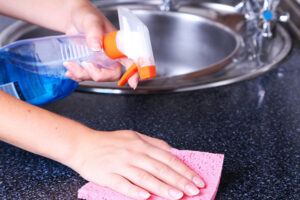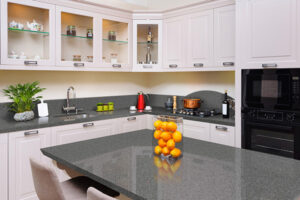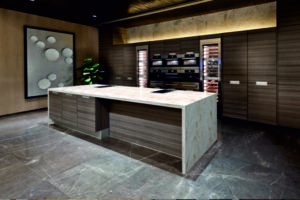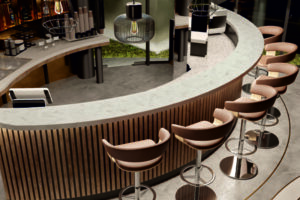
The most important about GRANDEX acrylic solid surface is that it is healthy and durable. At the same time, GRANDEX is also notable for being aesthetically pleasing and scenic.
Acrylic solid surface GRANDEX is used for manufacturing tabletops and window sills, integrated kitchen sinks and wash basins, wall panels and other parts of furniture and details of interior design.
This manual contains basic rules to maintain the items made of acrylic solid surface GRANDEX. Following these rules in everyday operation will ensure durability and ideal appearance of the surfaces made of GRANDEX.
Operating tips for surfaces made of GRANDEX
- It is not recommended to cook directly on the tabletop using knives and other sharp objects — meaning no chopping, cutting, or grinding. Protect the tabletop surface by using a chopping board.
- Be aware to do not use sharp or scratching objects on the GRANDEX surfaces, to prevent scratches and scuff marks.
- Please be aware that small scratches, dust and traces of natural wear on light surfaces with sand texture are less visible, than on dark surfaces with heavy shades or of a single color.
- Avoid putting pots, pans, and kettles, which have just been removed from fire, and other warmed-up kitchenware into the kitchen sink or directly onto the tabletop. Do not forget using trivets or similar made of heat-insulation material, and put a protective pad into your kitchen sink.
- First open the cold water tap if you need to pour boiling liquid into the sink, so that the boiling water for example mixes with cold water. This will help avoid the thermal shock, which may result in damaging the washbasin or kitchen sink.
- Make sure that the bottom of large cooking utensils, extending beyond the cooktop, does not hang out over the tabletop surface and does not touch it.
- Corrosive chemical substances (e.g., strong acidic liquids for cleaning sewer pipes, agents with methylene chloride for cleaning baking ovens and cookers, acetone and other similar substances) occasionally spilled onto the GRANDEX surface, shall be immediately washed off using soap solution and plenty of water. If you let chemicals sit for a longer time, they can damage the surface.
- Fiercely boiling water is dangerous for the GRANDEX surfaces — it can leave microcracks and whitish stains.
Routine care for the GRANDEX surfaces. Recommendations
Acrylic solid surface GRANDEX has no voids and microcracks, meaning it is impervious for different impurities and moisture. This ensures that dirt, grease and other household impurities that stay on the surface, are as a rule easy to remove with a sponge and conventional mild detergents.
Nevertheless, it is recommended to immediately remove any impurities and spilled liquids, especially colored ones, from the surface using a flannel or other soft cloth.
Shall there be any stubborn stains of iodine, brilliant green, ink, bright juice of fruits and vegetables or similar, consult the Section “how to remove complex stains”.
Taking care for kitchen sinks and wash basins made of GRANDEX. Recommendations
- Surface of kitchen sinks and wash basins shall be cleaned at least once a week.
- To remove remains of grease and vegetable oils one shall use a gel or liquid domestic detergent or special cleaning agent for items made of acrylic solid surface.
- Heavily polluted sink surfaces shall be treated with a mixture of household bleach with water (3:1 solution). The resulting mixture shall be homogenously applied to the soiled surface using sponge or sprayer, then let it sit for several hours. Make sure the cleaning mixture does not stay on the surface for more than 8 hours. Treated surface is to be thoroughly washed with plenty of water and wiped dry with a cloth.
- Put on protective gloves.
How to remove complex stains
Coffee, cocoa, tea, chocolate, lemon juice, vinegar, fruits, vegetable, ketchup
- Wipe the polluted area with a gel or liquid detergent. Wash the surface thoroughly with plenty of lukewarm water, and wipe thoroughly with a dry cloth.
- If the stain is still to be seen, apply a bit of soft cleaning abrasive paste, wash with water and thoroughly wipe with dry cloth.
- If necessary, dissolve 1 part of household bleach in 3 parts of water and apply it to the stain.
- Wash the surface with plenty of lukewarm water and thoroughly wipe entire surface with a dry cloth.
Beware!If using bleach, rinse it thoroughly with lukewarm water when done or whitish stains can appear on the surface.
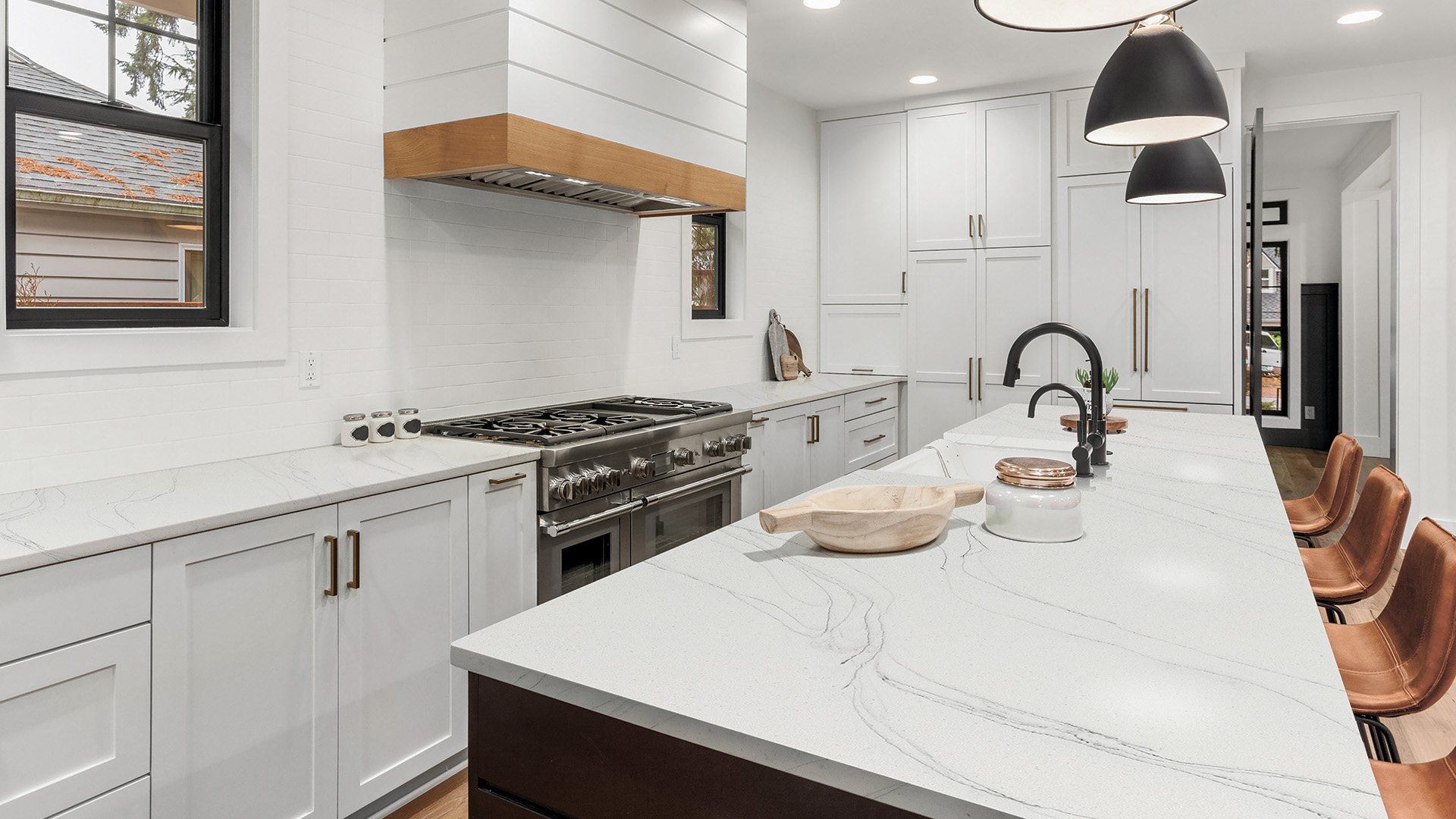

Grease, vegetable oil
- Wipe the polluted area with a gel or liquid detergent. Wash the surface thoroughly with plenty of lukewarm water, and wipe thoroughly with a dry cloth.
- If the stain is still to be seen, apply a bit of soft cleaning abrasive paste and rub in quiet circular motions.
- Wash the surface with plenty of lukewarm water and thoroughly wipe entire surface with a dry cloth.
Marks from hard water, and soap
- Wipe the polluted area with a gel or liquid detergent. Wash the surface thoroughly with plenty of lukewarm water, and wipe thoroughly with a dry cloth.
- Stains from hard water, and soap can be removed by using conventional domestic limescale remover.
- Wash the surface with plenty of lukewarm water and thoroughly wipe entire surface with a dry cloth.
Small scratches, pollen, shoe polish, cigarette burn, felt pen, marker pen, ink
- Wipe the polluted area with a gel or liquid detergent. Wash the surface thoroughly with plenty of lukewarm water, and wipe thoroughly with a dry cloth.
- If the stain is still to be seen, apply a bit of soft cleaning abrasive paste, wash with water and thoroughly wipe with dry cloth.
- If necessary, prepare a 3:1 solution of household bleach in water and apply to the stain.
- Wash the surface with plenty of lukewarm water and thoroughly wipe entire surface with a dry cloth.
Beware!If using bleach, rinse it thoroughly with lukewarm water when done or whitish stains can appear on the surface.
Red wine, blood, perfume
- Wipe the polluted area with a gel or liquid detergent. Wash the surface thoroughly with plenty of lukewarm water, and wipe thoroughly with a dry cloth.
- If the stain is still to be seen, apply a bit of soft cleaning abrasive paste, wash with water and thoroughly wipe with dry cloth.
- If necessary, apply household bleach diluted in water (3 parts of bleach and 1 part of water).
- Wash the surface with plenty of lukewarm water and thoroughly wipe entire surface with a dry cloth.
Beware! If using bleach, rinse it thoroughly with lukewarm water when done or whitish stains can appear on the surface.
Nail varnish
- Wipe the polluted area with a gel or liquid detergent. Wash the surface thoroughly with plenty of lukewarm water, and wipe thoroughly with a dry cloth.
- If the stain is still to be seen, apply a bit of soft cleaning abrasive paste, wash with water and thoroughly wipe with dry cloth.
- If necessary, use acetone-free varnish remover. Dampen the cloth with it and wipe the stain.
- Wash the surface with plenty of lukewarm water and thoroughly wipe entire surface with a dry cloth.
Rust OR Metallic corrosion
- Wipe the polluted area with a gel or liquid detergent. Wash the surface thoroughly with plenty of lukewarm water, and wipe thoroughly with a dry cloth.
- If the stain is still to be seen, apply a bit of soft cleaning abrasive paste, wash with water and thoroughly wipe with dry cloth.
- If necessary, apply a bit of agent used for cleaning metal or rust remover to a cloth. Wipe the polluted surface.
- Wash the surface with plenty of lukewarm water and thoroughly wipe entire surface with a dry cloth.
Iodine, mildew
- Wipe the polluted area with a gel or liquid detergent. Wash the surface thoroughly with plenty of lukewarm water, and wipe thoroughly with a dry cloth.
- If the stain is still to be seen, apply a bit of soft cleaning abrasive paste, wash with water and thoroughly wipe with dry cloth.
- If necessary, prepare a 3:1 solution of household bleach in water and apply to the stain.
- Wash the surface with plenty of lukewarm water and thoroughly wipe entire surface with a dry cloth.
Beware! If using bleach, rinse it thoroughly with lukewarm water when done or whitish stains can appear on the surface.
Shall you not be able to remove the stain yourself, seek advice from the service center.
Repairing items made of GRANDEX
Acrylic solid surface GRANDEX is distinguished by its excellent repairability.
Shall the GRANDEX surface be damaged during operation, it can be renovated. Seek advice from certified fabricators of acrylic solid surface GRANDEX.










